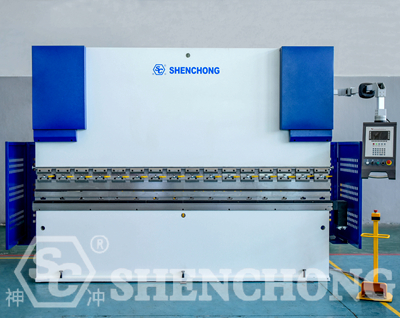
SHENCHONG 110 ton CNC hydraulic press brake machine is a commonly used medium-to-large tonnage machine for bending and forming metal sheets. It is commonly used in industries such as sheet metal, cabinets, furniture, doors and windows, and automotive parts.
This tonnage is suitable for bending common steel and stainless steel materials of small to medium lengths within the range of 1–6 mm (depending on the material). Common working lengths include 2.5m and 3.2m. Manufacturers often equip it with CNC systems such as DELEM/ESTUN/ESA/SC EL, servo/hydraulic back gauge, automatic support, and automatic pressing/compensation (crowning) functions to improve accuracy and efficiency.

- Nominal Pressure: 110 ton (≈110 tons of force) / approximately 1,100 kN.
- Bending Length (Table Length): 2500 mm, 3200 mm (common) or longer (depending on machine type).
- Ram Stroke: Commonly around 200 mm (150–210 mm for different models).
- Throat Depth: Approximately 150–410 mm, affecting bending depth and workpiece dimensions.
- Main Motor Power: 8–15 kW (depending on stroke, pump, and manufacturer).
- Number of Control Axes: Commonly 4+1 (Y1/Y2 + X back gauge) to high-end configurations such as 8 axes (including R, Z, and rotary axes). Controller examples: DELEM DA58/DA66, ESA S630/S640, SC EL 15/19.
- Repeat positioning accuracy: High-end machines can reach ±0.01 mm (depending on the scale/servo system).
- Frame: Provides load-bearing and rigid foundation; welded parts undergo aging treatment and precision machining.
- Hydraulic System: Includes oil pumps, hydraulic valves, cylinders, and oil tanks. Responsible for providing bending force and slider movement. Oil quality and temperature control directly affect performance.
- CNC System: DELEM/ESA/SC EL is used for inputting bending angles, compensation, process programs, and collision simulation. High-end control can perform 3D simulation and automatic crowding compensation.
- Back Gauge: Typically a ball screw/servo drive or servo + ball joint, determining positioning speed and accuracy.
- Punch & Die: V-die, U-die, forming die, etc. Die selection affects the required tonnage and forming accuracy.
- Automatic Top Pressing/Electric Crowning: Used to overcome slider bending, ensuring uniform bending along the entire length.
- Machine Tool Positioning and Foundation: Confirm the machine tool is level, bolts are securely fastened, anchor bolts are tightened, and grounding is good.
- Hydraulic Oil and Power Supply: Add the manufacturer-specified hydraulic oil and check the oil level. Connect the power supply and confirm electrical wiring, grounding, and leakage protection.
- Controller Zeroing and Parameter Setting: Zero the CNC, calibrate the back gauge, and calibrate the grating/encoder. If there is an automatic compensation/pressure function, calibrate according to the instruction manual.
- Mold Installation and Alignment: Install the upper/lower mold and confirm alignment and clearance (leave a plate thickness clearance when the upper mold is lowered to avoid jamming).
- No-Load Cyclic Test Run: Run the machine under no-load, checking the up and down strokes, back gauge movement, emergency stop, and safety light curtain activation.
- Overheating/Unstable Pressure: Check the oil level in the tank, the oil cooler, and whether the oil quality has deteriorated. Check if the hydraulic valves are stuck.
- Backgauge positioning error/repetitive deviation: Check the ball screw lubrication, encoder/scaler wiring, and servo drive alarm log.
- Poor repeatability/uneven angle along the entire length: Determine whether the machine requires manual or electric crowning. Check for slide bending or base deformation. High-end machines often have automatic crowning systems.
- Controller alarm or program anomaly: Save the alarm code, refer to the controller manual, restart the controller, and check grounding and interference sources.

- Determine the maximum bending length and the materials you typically process (e.g., if you frequently process 3200×3mm stainless steel, choose a 3.2m worktable and allow for margin).
- Tonnage Allowance: After calculating the required tonnage, allow a 15–25% margin to account for material batch variations and process changes.
- Control System and Number of Axes: If complex processes or batch production are required, a 6–8-axis or 3D control system (with simulated collision detection and angle compensation) is preferred.
- Back Gauge Drive: Servo drive + ball screw (or synchronous belt + servo) offers advantages in speed and accuracy.
- After-Sales Service and Accessories: Prefer manufacturers with a well-established after-sales network and standard mold supply to reduce the risk of downtime.
The 110 ton CNC hydraulic press brake is a medium-tonnage bending machine commonly used for sheet metal parts, small computer cases, furniture components, door and window accessories, and other applications. Typical working lengths are 2500mm or 3200mm. It can be equipped with DELEM/ESA/SC EL CNC systems, servo back gauge, automatic compensation (crowning), etc., and is suitable for small-batch, multi-variety and medium-batch production.